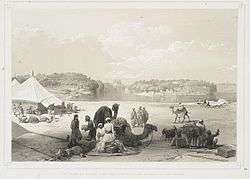Aror

Aror (Sindhi: اروهڙ) or Alor or Arorkot (Sindhi: اروهڙ ڪوٽ) is the medieval name of the city of Rohri (in Sindh, modern Pakistan).[1][2] In ancient India, Aror once served as the capital of Sindh.[3]
History
Aror is the ancestral town of the Arora caste.[4] According to the Bhavishya Purana, Parshuram attacked the Kshatriyas but eventually met one who refused to oppose the Brahmins. This caused Parshuram to gain respect for him and as a result Parshuram asked this Kshatriya to settle in Sind, in Arorkot. This Kshatriya's descendants were named after the place.[2]
Arab historians used the words Al-rur, Al-ruhr and Al Ror to describe Aror.[5] The basic meaning being "The Ror" as 'Al' is simply the English word 'The' in Arabic. Aror was the ancient capital of Sindh, originally ruled by the Ror Dynasty, which was followed by Rai Dynasty and then the Brahman Dynasty. Modern Rohri is now situated close to Sukkur, Sindh. In 711, Aror was captured by the army of Muslim general Muhammad bin Qasim. In 962 it was hit by a massive earthquake that changed the course of the Indus River[6]
References
- ↑ Malhotra, Anshu (2002). Gender, Caste, and Religious Identities: Restructuring Class in Colonial Punjab. Oxford University Press. ISBN 9780195656480. Retrieved 8 October 2014.
The Aroras were also said to be the Khatris of Arorkot, or Aror, the ancient capital of Sindh.
- 1 2 Singh, Kumar Suresh; Ghosh, Tapash Kumar; Nath, Surendra (1996). People of India: Delhi. Anthropological Survey of India. ISBN 9788173040962. Retrieved 8 October 2014.
The Arora or Rora is a community of traders of the south-western part of the Punjab. Their origin according to the Bhavishya Purana, can be traced back to the time of Parshuram, who in anger started killing the Kshatriyas. In this process, Parshuram met a Kshatriya who refused to oppose the Brahmans, and winning Parshuram's respect, was asked to go to Sindh to setde there. Later, the place came to be known as Arutkot or Arorkot. His progeny are called Aroras.
- ↑ Handbook of the Punjab, Western Rajputana, Kashmir, and Upper Sindh. John Murray. 1883. p. 293. Retrieved 8 October 2014.
Aror.--While at Rorhi, a visit may be paid to the very ancient town of Aor, which is only 5 m. distant to the E. This was the capital of the Hindu Rajas of Sindh and was taken from them by the Muslims, under Muhammad Kasim, about 711 A.D. At that time the Indus washed the city of Aror, but it was diverted from it by an earthquake about 962 A.D., at which the river entered its present channel.
- ↑ Denzil Ibbetson (1970). Panjab Castes. Languages Department, Punjab.
- ↑ "Alor or Aror of the Muslims is really Al Ror which is the same as Roruka or Roruva, the name of the ancient Sauvira capital", Page 45, History of the Punjab, Volume 1 by Fauja Singh, Published by the Department of Punjab Historical Studies, Punjabi University, 1977
- ↑ Rose, H. A, (1911). A Glossary of The Tribes & Castes of The Punjab & North West Frontier Province. II. Lahore: Samuel T. Weston. p. 17. Retrieved 2011-10-24.
Coordinates: 27°39′00″N 68°59′00″E / 27.65°N 68.9833°E